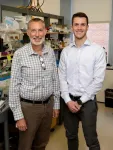(Press-News.org) Fever temperatures rev up immune cell metabolism, proliferation and activity, but they also — in a particular subset of T cells — cause mitochondrial stress, DNA damage and cell death, Vanderbilt University Medical Center researchers have discovered.
The findings, published Sept. 20 in the journal Science Immunology, offer a mechanistic understanding for how cells respond to heat and could explain how chronic inflammation contributes to the development of cancer.
The impact of fever temperatures on cells is a relatively understudied area, said Jeff Rathmell, PhD, Cornelius Vanderbilt Professor of Immunobiology and corresponding author of the new study. Most of the existing temperature-related research relates to agriculture and how extreme temperatures impact crops and livestock, he noted. It’s challenging to change the temperature of animal models without causing stress, and cells in the laboratory are generally cultured in incubators that are set at human body temperature: 37 degrees Celsius (98.6 degrees Fahrenheit).
“Standard body temperature is not actually the temperature for most inflammatory processes, but few have really gone to the trouble to see what happens when you change the temperature,” said Rathmell, who also directs the Vanderbilt Center for Immunobiology.
Graduate student Darren Heintzman was interested in the impact of fevers for personal reasons: Before he joined the Rathmell lab, his father developed an autoimmune disease and had a constant fever for months on end.
“I started thinking about what an increased set point temperature like that might do. It was intriguing,” Heintzman said.
Heintzman cultured immune system T cells at 39 degrees Celsius (about 102 degrees Fahrenheit). He found that heat increased helper T cell metabolism, proliferation and inflammatory effector activity and decreased regulatory T cell suppressive capacity.
“If you think about a normal response to infection, it makes a lot of sense: You want effector (helper) T cells to be better at responding to the pathogen, and you want suppressor (regulatory) T cells to not suppress the immune response,” Heintzman said.
But the researchers also made an unexpected discovery — that a certain subset of helper T cells, called Th1 cells, developed mitochondrial stress and DNA damage, and some of them died. The finding was confusing, the researchers said, because Th1 cells are involved in settings where there is often fever, like viral infections. Why would the cells that are needed to fight the infection die?
The researchers discovered that only a portion of the Th1 cells die, and that the rest undergo an adaptation, change their mitochondria, and become more resistant to stress.
“There’s a wave of stress, and some of the cells die, but the ones that adapt and survive are better — they proliferate more and make more cytokine (immune signaling molecules),” Rathmell said.
Heintzman was able to define the molecular events of the cell response to fever temperatures. He found that heat rapidly impaired electron transport chain complex 1 (ETC1), a mitochondrial protein complex that generates energy. ETC1 impairment set off signaling mechanisms that led to DNA damage and activation of the tumor suppressor protein p53, which aids DNA repair or triggers cell death to maintain genome integrity. Th1 cells were more sensitive to impaired ETC1 than other T cell subtypes.
The researchers found Th1 cells with similar changes in sequencing databases for samples from patients with Crohn’s disease and rheumatoid arthritis, adding support to the molecular signaling pathway they defined.
“We think this response is a fundamental way that cells can sense heat and respond to stress,” Rathmell said. “Temperature varies across tissues and changes all the time, and we don’t really know what it does. If temperature changes shift the way cells are forced to do metabolism because of ETC1, that’s going to have a big impact. This is fundamental textbook kind of stuff.”
The findings suggest that heat can be mutagenic — when cells that respond with mitochondrial stress don’t properly repair the DNA damage or die.
“Chronic inflammation with sustained periods of elevated tissue temperatures could explain how some cells become tumorigenic,” Heintzman said, noting that up to 25% of cancers are linked to chronic inflammation.
“People ask me, ‘Is fever good or bad?’” Rathmell added. “The short answer is: A little bit of fever is good, but a lot of fever is bad. We already knew that, but now we have a mechanism for why it’s bad.”
The research was supported by the National Institutes of Health (grants R01DK105550, R01HL136664, R01CA217987, R01HL118979, R01AI153167, R01CA245134, T32AI112541, T32DK101003, T32AR059039, K00CA253718), Lupus Research Alliance, Waddell Walker Hancock Cancer Discovery Fund, and National Science Foundation.
END
Fever drives enhanced activity, mitochondrial damage in immune cells
2024-09-20
ELSE PRESS RELEASES FROM THIS DATE:
A two-dose schedule could make HIV vaccines more effective
2024-09-20
One major reason why it has been difficult to develop an effective HIV vaccine is that the virus mutates very rapidly, allowing it to evade the antibody response generated by vaccines.
Several years ago, MIT researchers showed that administering a series of escalating doses of an HIV vaccine over a two-week period could help overcome a part of that challenge by generating larger quantities of neutralizing antibodies. However, a multidose vaccine regimen administered over a short time is not practical for mass vaccination campaigns.
In a new study, the researchers have now found that they ...
Wastewater monitoring can detect foodborne illness, researchers find
2024-09-20
UNIVERSITY PARK, Pa. — First used in the 1940s to monitor for polio, wastewater surveillance proved such a powerful disease monitoring tool that the U.S. Centers for Disease Control and Prevention (CDC) established the National Wastewater Surveillance System to support SARS-CoV-2 monitoring in September of 2020. Now, a team of scientists from Penn State and the Pennsylvania Department of Health have shown that domestic sewage monitoring is useful for a foodborne pathogen as well.
In findings published today (Sept. 19) in the Journal of Clinical ...
Kowalski, Salonvaara receive ASHRAE Distinguished Service Awards
2024-09-20
Building equipment and envelope scientists at the Department of Energy’s Oak Ridge National Laboratory were recognized for research excellence during the ASHRAE 2024 summer conference held in Indianapolis.
Stephen Kowalski and Mikael Salonvaara received the Distinguished Service Award, which salutes members who have served the society with distinction in chapter, regional and society activities. Kowalski and Salonvaara have each been active members of ASHRAE for more than 25 years and have supported the organization’s Technical and Standards Project Committees.
ASHRAE is the largest international professional organization ...
SkAI launched to further explore universe
2024-09-20
Funded by a five-year, $20 million grant from the U.S. National Science Foundation (NSF) and the Simons Foundation, the National Center for Supercomputing Applications is partnering with other academic institutions and federal laboratories in the Midwest to develop new artificial intelligence (AI) tools to advance astrophysics research and exploration of the universe.
Led by Northwestern University, the collaboration will establish the NSF-Simons AI Institute for the Sky or SkAI (pronounced “sky”), one of two AI research centers that will help astronomers better understand the cosmos.
Located close to NCSA’s home in Illinois, SkAI will ...
SLU researchers identify sex-based differences in immune responses against tumors
2024-09-20
ST. LOUIS — Researchers at Saint Louis University School of Medicine investigated differences in T-cell responses between male and female patients with lung cancer that may help direct future treatments. T-cell responses are part of the adaptive immune system, part of the body’s “smart system” that monitors for threats and fights them with customized defenses.
"Therapies that use the patient's immune system to fight their disease have a lot of potential to ...
Evolved in the lab, found in nature: uncovering hidden pH sensing abilities
2024-09-20
By Andy Flick, Evolutionary Studies scientific coordinator
In a groundbreaking study led by Sarah Worthan, Ph.D., a postdoctoral researcher in the Behringer Lab at Vanderbilt University, scientists have successfully evolved microbial cultures that possess the ability to sense pH changes, enabling rapid responses to environmental fluctuations. Along with highlighting the power of lab-driven evolution, this discovery also led to finding similar mutations in nature in emerging pathogens and coral symbionts—organisms that navigate challenging pH shifts in their environments and are ...
Unlocking the potential of patient-derived organoids for personalized sarcoma treatment
2024-09-20
Investigators at the UCLA Health Jonsson Comprehensive Cancer Center have developed the largest collection of sarcoma patient-derived organoids to date that can help improve the understanding of the disease and better identify therapies that are most likely to work for each individual patient.
The approach, detailed in the journal Cell Stem Cell, uses patients’ own tumor cells that replicate the unique characteristics of a patient's tumor allowing scientists to quickly screen a large number of drugs in order to identify personalized treatments that can target this rare and diverse group of cancers.
“Sarcoma is a rare and complex disease, which makes conducting clinical trials ...
New drug molecule could lead to new treatments for Parkinson’s disease in younger patients
2024-09-20
A novel drug molecule could potentially lead to new treatments to prevent Parkinson’s disease in younger patients, according to new research.
“We are excited about this drug compound because we might have the possibility to develop the first cure for Parkinson’s disease, at least for a subset of patients,” said lead author Kalle Gehring, a Professor in the Department of Biochemistry at McGill University and Canada Research Chair in Structural Studies of Neurodegenerative Diseases.
While Parkinson’s symptoms — slowed movements, tremors and balance problems — often appear in ...
Deforestation in the Amazon is driven more by domestic demand than by the export market
2024-09-20
Brazilian Legal Amazonia (BLA) – which comprises the entirety of the Amazon Basin located in Brazil and vast adjacent swathes of the Cerrado, spanning nine states – is more than 5 million square kilometers (km2) in area and corresponds to almost 60% of the country’s land mass. Almost a quarter of this area (23%) has been deforested, and over 1 million km2 are degraded, so that the region risks reaching an ecological tipping point at which ecosystems collapse and billions of tons of carbon are released into the atmosphere. Some parts of ...
Demand-side actions could help construction sector deliver on net-zero targets
2024-09-20
Using state-of-the-art energy efficiency technologies to renovate existing properties and construct new ones could enable Europe’s construction sector to almost eliminate its carbon emissions by 2060, a new study suggests.
Published in the journal Renewable and Sustainable Energy Reviews, the research is the first to fully assess the potential for energy demand reduction across the construction sectors of the United Kingdom and all European Union member states.
It highlights that 75% of Europe’s building stock is currently classed as energy inefficient, with total floor space also ...




